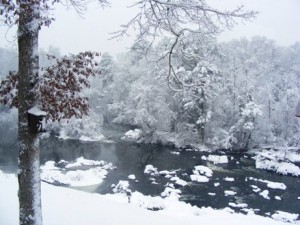… Or, How do Bobwhites Fare in Bad Winters?
 |
|
The topic on everyone’s mind these past few weeks has been, “When will this blasted winter ever end?” Few Americans escaped winter’s effects this year. In my home state of Virginia it has been one of the worst 3 or 4 winters in my 51 years of breathing air on this planet. I do recall back in the late 1970s a couple of winters in southwest Virginia that were severe by most standards. Of course, compared to Wisconsin where quail used to thrive, and where some important early research was done on quail (Paul Errington – Aldo Leopold’s first doctoral student in wildlife), I suspect our winter would not have been considered severe.
I won’t get too scientific on you, partly because I don’t have a great deal of time to really delve into old literature and see what I can find about winter weather’s effects on bobwhite populations. But also because I prefer to take a practical approach whenever possible. I picture a bobwhite covey out there making a snowman of their own, using partridge pea seeds for buttons, of course, lespedeza for eyes and maybe a beggar weed pod for a long nose. Sorry, I’m digressing.
Bobwhites occur in a very wide geographic area – from Mexico all the way into the northern prairies and east through Michigan, Wisconsin and even into southern Maine at one point – though I doubt many occur there now. Obviously, they can adapt to extreme winter weather. Some say, perhaps, that a Texas quail is vastly different from a Wisconsin quail, but in reality those who get into sub-speciation are truly hair splitters –the similarities among sub-species far outweigh the differences.
What we do know about bobwhites, as for just about any other animal, is that when they become stressed by cold they need more calories to maintain their body heat. Guthery (2000) in his book “On Bobwhites” (available in NBCI’s online store at https://nbgi.org/donate-2/online-store) states that at 32 degrees (F) a bobwhite needs 50 kilocalories a day to maintain itself. This equals about 550 milo seeds per bobwhite.
Of course, bobwhites have other ways of mitigating for cold weather. They roost at night in a tightly packed disk which helps them conserve heat, among other things. They also seek areas where cover and terrain gives them protection from winds. During the day they may seek small micro-climate areas on southern slopes where the sun provides some thermal relief. And, of course, they eat more.
All wild animals are extremely resourceful when it comes to surviving, but they can and do reach a point when cold weather becomes deadly…well at least it is the proximate cause. I would argue the ultimate cause is often the fact that they inhabit “sub-optimal range.” In layman’s terms that means their habitat is not adequate.
During the mid-1990s I was a field crew leader on a Virginia quail study involving numerous bobwhites with radio-transmitters affixed during February. We were actually able to track them through 2 substantial snowfalls during the first and third weeks of February that year. We found they shifted their range and moved into pine forests where heavy cover limited snow depth and also where numerous greenbrier thickets occurred. We did not do a food analysis, but assumed that they were feeding on abundant greenbrier berries, as grouse often do. There were a couple of occasions when we did believe quail died due to exposure. These were instances when the weather changed rapidly, going from very warm to very cold overnight in late winter – similar to some conditions we have seen in Virginia this year.
In Oklahoma, during a study in the early to mid-1990s (Peoples et al., 1994 – Progress Report Packsaddle Northern Bobwhite Mortality Study), researchers found that as much as 19% of winter mortality was due to severe weather. However, when averaged out over all seasons and areas, weather only accounted for 2% of annual mortality. When an average quail population suffers 80% to 90% mortality annually – which is a now a known, well-accepted fact throughout much of their range – it would seem that winter weather overall is a minor mortality factor. I believe that to be true here.
This winter’s weather probably did kill a few quail. But quail are adapted to high mortality rates and if they have adequate habitat and a good nesting season, they can bounce back faster than a super ball coming at you off a brick wall. Our primary problem here in Virginia has been, and continues to be, too little good quail habitat. Other factors compound this problem. New research on neonicotinoid (nicotine based) pesticides suggests they could play a role.
Regardless of other factors, quail can’t survive on concrete, asphalt or fescue. Every landowner’s best insurance for having quail year-in and year-out is to have excellent quail habitat. And as much of it as you can stand.
March 21, 2014






